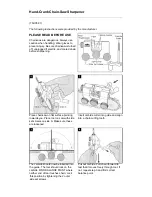
Straight Line Bevel Shaping
To shape a beveled straight edge, use a bevel-
edge shaping jig in combination with the regular
fence as shown in Figure 31.
Figure 31
To perform a bevel-edge cut, the in-feed edge of
the jig is placed against the infeed fence and
clamped to the table as shown in Figure 32. The
outfeed fence is moved forward as necessary to
compensate for the cut.
Figure 32
Never attempt to bevel cut free
hand. Always use a bevel-edge fixture.
Contour Edge Shaping With Collar Bearing
To shape contoured edges, the operator must first
remove the fence assembly.
In order to control the workpiece and limit the
depth-of-cut, the operator must use an anti-friction
collar with the cutter(s) as shown in Figure 33.
Figure 33
The collar may be positioned above or below the
cutter(s), and its function is to ride against the
workpiece or template. At the same time, the collar
will establish the depth-of-cut as shown in
Figure 34. Whenever possible, always use the ring
guard or safety collar.
Figure 34
Note:
Since the collar requires at least 1/8" of
surface edge to ride against, the entire edge cannot
be shaped as shown in Figure 35. The added use
of a pattern, however, permits the shaping of the
entire contour edge.
Figure 35
25
Summary of Contents for JWS-35X Series
Page 36: ...Table Assembly Drawing 36...
Page 38: ...Fence Assembly Drawing 38...
Page 42: ...Cabinet and Base Assembly Drawing 42...
Page 48: ...Notes 48...
















































